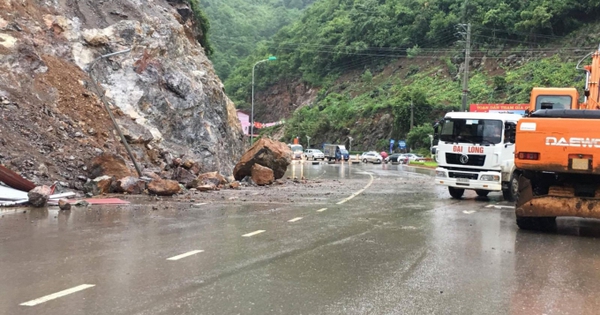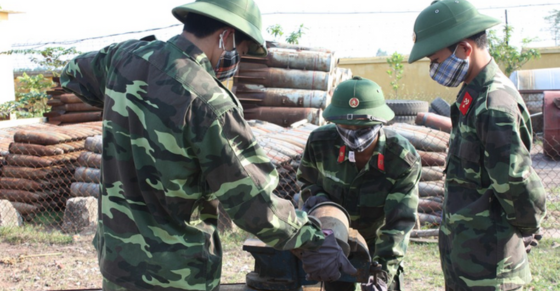Work to overcome the consequences of natural disasters and ensure traffic for road projects in operation in Vietnam
Currently, how is the work of overcoming the consequences of natural disasters and ensuring traffic for road works in operation in Vietnam? – Huu Chien (Binh Dinh)

Work to overcome the consequences of natural disasters and ensure traffic for road projects in operation in Vietnam (Internet image)
Work to overcome the consequences of natural disasters and ensure traffic for road projects in operation in Vietnam
The content mentioned in Article 13 of Circular 03/2019/TT-BGTVT is amended in Clause 9, Article 1 of Circular 43/2021/TT-BGTVT, and Clause 10, Article 1 of Circular 22/2023/TT-BGTVT).
(1) Overcome consequences of natural disasters, handle congestion, and ensure traffic
When a natural disaster occurs that affects and disrupts part or all of traffic activities, according to the motto "four on the spot" specified in Clause 3, Article 4 of the Law on Natural Disaster Prevention and Control, the Road Management Agency and contractors who manage, regularly maintain, and operate road works are responsible for immediately overcoming the consequences of natural disasters, handling congestion, and ensuring road traffic. This activity includes one or more of the following tasks:
- Appoint people to be on duty, stretch ropes, fence, and post temporary signs at both ends of the damaged section; clean up, level, and repair to ensure at least 1 lane of traffic is safe. Road sections or structures that are seriously damaged must be fenced, have guards to command and control traffic, organize traffic flow to ensure traffic, and make announcements on mass media. In cases where the depth of flooding is large and the flow is strong, it is necessary to install marker posts, buoys, and water markers and coordinate with local authorities to make barriers and channel dividers, ban vehicles, regulate traffic, and issue other warnings if necessary;
- Electric poles and trees fall onto the road; Mud, soil, rocks, pebbles, trees, and garbage overflow the foundation and road surface, clog the drainage system, and obstruct the flow of sewers, ditches, and under bridges: Focus on sawing, chopping, cleaning up fallen trees, and moving electric poles out of the road surface; Cleaning the foundation and road surface; Clearing culverts, ditches, rivers, and streams under bridges for safe traffic;
- Landslides and rocks are pushed down to the ground and road surface: digging and digging to destroy unstable rocks, clearing away landslides, and rolling them down; When it is necessary to stabilize the foot of the road, use steel gabion embankments or materials suitable to the actual conditions in the area to maintain stability for safe vehicle circulation;
- Acoustic landslides and subsidence encroaching on the foundation and road surface: depending on the actual terrain, arrange steel gabion embankments or use shaped steel piles or sheet piles to create anti-sink retaining walls, or use remedial and repair plans using materials suitable to the actual conditions in the area; When the negative slope is eroded, the remaining road surface width is ≤ 3.0 m. Temporarily fill ditches or cut into the toe of the positive slope to achieve a road surface width of ≥ 4.0 m to temporarily open traffic, then complete for normal traffic;
- Small bridges, culverts, underground overflows, rescue roads, and drainage systems are eroded, landslides ưhat are dislodged or locally flooded, and other cases of damage affecting road traffic and construction safety include: carry out clearing and dredging of mud, soil, and rocks to ensure drainage; Reinforce the damage with one or several materials, such as: cement concrete, reinforced concrete, steel gabions, or other materials suitable to the actual conditions of the area for safe vehicle circulation;
- In case the road surface is sagging, potholed, or locally damaged; Eroded sidewalks: handle local damage, level, and ensure a smooth road surface; Reinforce the sidewalk with steel gabions or other materials suitable to the actual conditions in the area for safe vehicle circulation;
- Broken or damaged road signaling and traffic safety defense systems: repair, replace, or supplement immediately to guide and ensure safe and smooth traffic;
- In case of overcoming the consequences of natural disasters, handling congestion, and ensuring traffic specified in Points a, b, c, d, dd, e, g, Clause 1, Article 13 of Circular 03/2019/TT-BGTVT exceed the unit's ability to perform, according to the scope and management responsibilities, the contractor for management, regular maintenance, and operation of road works reports to the Road Management Area or the Department of Transport to mobilize additional units to promptly overcome the consequences caused by natural disasters.
(2) Repair damage and restore road works
When natural disasters occur causing damage to road works, the consequences must be immediately overcome to restore traffic operations and restore part or all of the work according to the standards and technical regulations of the project before it is damaged. The competent authority shall decide to implement an emergency project to prevent, combat, and overcome the consequences of natural disasters according to the provisions of Article 11a of Circular 03/2019/TT-BGTVT. This activity includes one or more of the following tasks:
- The Luy Duong slope is subject to landslides and sliding arc cracks appear, rocks are cracked, rocks fall, rocks roll down onto the road, and there is a risk of further landslides, drifting, and sliding: Carry out mechanical cutting, lower the load to reduce part or all of the sliding arc, or cover the steel mesh with anchors pinned to the rock slope roof, open a local bypass to temporarily open traffic, then complete it for normal traffic;
- Landslides and landslides penetrate deeply into the road surface, and there is a risk of further landslides, drifting, and sliding leading to road breaks: Depending on the terrain and geology, use shaped steel piles to create a retaining wall to prevent collapse, combine with a steel gabion embankment, or open a temporary road to the west side of Luong Duong to temporarily open it to traffic, then complete it for normal traffic;
- Road surface with subsidence, rubber, subsidence, dense potholes, rutting, cracks, broken road surface: leveling, ensuring smooth road surface; After the weather allows immediate repair with suitable materials or return to the old structure or an equivalent structure and traffic safety system to ensure traffic safety, construction safety, and in accordance with operating conditions;
- Collapse or erosion of spillway, underground, or culvert; other cases of damage to road works that pose a direct threat to the safety of many people's lives: repairing, strengthening works, opening local bypasses to temporarily open traffic, or building temporary bridges to open the main route to traffic, then completing it to open to normal traffic;
- Road tunnel collapse; drifting and collapsing road bridges; erode a section of road: build a local bypass or temporary bridge to temporarily open traffic, then complete it for normal traffic;
- In addition to the solutions to repair damage and restore road works specified in Points a, b, c, d, and dd of this Clause, competent authorities may supplement other repair solutions in the Emergency Construction Construction Order to promptly handle the consequences caused by natural disasters.
(3) Based on the results and current status of overcoming the consequences of natural disasters, handling congestion, ensuring traffic according to the provisions of Points a, b, c, d, d, e, and g of Clause 1, Article 13 of Circular 03/2019/TT-BGTVT, competent authorities continue to handle as follows:
- Road works still exist or continue to be damaged but do not need to be immediately restored according to the project's standards and regulations. Before being damaged, the road management agency reports to the competent authority to consider and decide to carry out unexpected repairs to the project according to the provisions of Circular 37/2018/TT-BGTVT dated June 7, 2018 of the Minister of Transport regulating the management, operation, exploitation, and maintenance of road works;
- For road works that remain or continue to be damaged and need to be immediately restored according to the standards and regulations of the work before being damaged, road management agencies report to competent authorities to consider and decide to implement emergency projects to prevent, combat, and overcome the consequences of natural disasters according to the provisions of Article 11a of this Circular. Work has been done to overcome the consequences of natural disasters, handle congestion, and ensure traffic according to the provisions of Points a, b, c, d, dd, e, g, Clause 1, Article 13 of Circular 03/2019/TT-BGTVT approved in the project completion dossier;
- In case traffic operations remain or continue to be interrupted, overcoming the consequences of natural disasters, handling congestion, and ensuring traffic has expected costs with a total value exceeding the limit stipulated in Clause 1, Article 54 of Decree 63/2014/ND-CP dated June 26, 2014 of the Government, according to the scope and management responsibilities, contractors for management, regular maintenance, and operation of road works must report to the Road Management Area, Department of Transport to propose to competent authorities to consider and decide to implement urgent projects to prevent, combat and overcome the consequences of natural disasters according to the provisions of Article 11a of this Circular. Work has been done to overcome the consequences of natural disasters, handle congestion, and ensure traffic according to the provisions of Points a, b, c, d, dd, e, g, Clause 1, Article 13 of Circular 03/2019/TT-BGTVT approved in the project completion dossier.
Duong Chau Thanh
- Key word:
- natural disasters
- in Vietnam
- Number of deputy directors of departments in Vietnam in accordance with Decree 45/2025/ND-CP
- Cases ineligible for pardon in Vietnam in 2025
- Decree 50/2025 amending Decree 151/2017 on the management of public assets in Vietnam
- Circular 07/2025 amending Circular 02/2022 on the Law on Environmental Protection in Vietnam
- Adjustment to the organizational structure of the Ministry of Health of Vietnam: Certain agencies are no longer listed in the organizational structure
- Vietnam aims to welcome 22-23 million international tourists in Vietnam in 2025
-

- Types of natural disasters requiring forecast ...
- 11:00, 12/09/2024
-

- Emergency response and search and rescue organizations ...
- 10:29, 11/09/2024
-

- Handling of the acceptance results of ministerial ...
- 09:30, 11/09/2024
-

- Guidance on unexploded ordnance investigation ...
- 18:30, 09/09/2024
-

- Sources of the National database on construction ...
- 16:37, 09/09/2024
-

- Notable new policies of Vietnam effective as of ...
- 16:26, 11/04/2025
-
.Medium.png)
- Notable documents of Vietnam in the previous week ...
- 16:21, 11/04/2025
-
.Medium.png)
- Notable documents of Vietnam in the previous week ...
- 16:11, 02/04/2025
-
.Medium.png)
- Notable new policies of Vietnam to be effective ...
- 16:04, 02/04/2025
-
.Medium.png)
- Notable new policies of Vietnam effective from ...
- 14:51, 21/03/2025

 Article table of contents
Article table of contents
